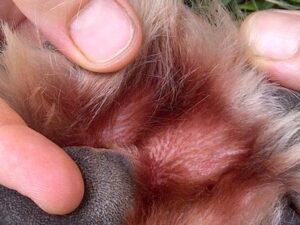Atopic dermatitis (atopy) is an inherited allergic skin disease of dogs. The condition is characterised by inflammation, itchiness, repeated skin and ear infections. The face, ear flaps, abdomen and underarms areas are affected. Advanced cases have skin changes caused by self-inflicted damage, including red-brown saliva staining of light coloured hair, hair loss and black mottled discolouration of the skin.

The hair on this paw is stained a reddish brown colour from saliva, a sign of excessive licking.
Any dog can become atopic but some breeds, such as West Highland White Terriers are much more prone and others, such as Greyhounds almost never get atopy. Affected dogs are born with the condition and develop symptoms when they have an abnormal immune response to allergens. The main source of allergens is the house dust mite. These tiny creatures live in carpets, beds and other soft furnishings and feed on skin debris that falls off people and animals. They litter our environments with faecal pellets of half-digested food and digestive enzymes which contain the most important allergens. Dogs can also become allergic to pollens and moulds although this is much less common, presumably because of less exposure.
Clinical signs
The first signs of atopy are often seen between 9 months and 3 years of age, but it can develop in younger and older dogs. Many cases are very mild in the first year and may go unnoticed. The main signs are excessive licking or chewing of the paws, abdomen, groin and underarms and the area under the tail. The ears may be reddened and hot to touch even if not scratched. As a result of this itchiness (pruritus) a dog may be treated a number of times in the first eighteen months of life for a variety of minor skin conditions. As the condition develops itchiness dominates the dog’s life and specific anti-itch therapy is required. Hair loss, redness of the skin and secondary infections with yeast or bacteria become more common with increased scratching. Some breeds may be more affected in one location such ears in Labradors and feet in Poodles.
Diagnosis
There is no definitive test to confirm a diagnosis of atopy but a veterinary practitioner may suspect atopy after examining a patient. Clinical signs and a history of previous episodes of a similar skin disease often indicate atopy. Other possible causes of skin irritation such as parasites should be eliminated first. Laboratory tests including blood tests, skin scrapings, skin swabs and skin biopsies may be required to do so.
Atopy causes itching and skin inflammation, and the resulting scratching and licking damages the skin further. Bacteria and yeasts normally found on the skin can easily get into inflamed and damaged skin leading to secondary infections causing more itching. The additional itching increases damage to the skin causing more infection and inflammation and deterioration of the overall condition. This is referred to as the ‘itch-scratch’ cycle.
Treatment
The aim of treatment is to reduce inflammation and itchiness and treat secondary infections. Treatment may include anti-inflammatories, antibiotics and medicated shampoos. In some cases a long course of treatment of 3 weeks or more may be necessary, and some patients may need life-long treatment. As fleas and other skin parasites make an atopic dog far itchier treating these parasites is essential.
Medication
Corticosteroids are the drug of choice in severe cases of atopic dermatitis. There are many side effects which may outweigh the benefits. When used appropriately, and when complicating diseases are under control, side effects are generally minimal.
* Ciclosporin is one of the most effective treatments for atopy. In more than half of patients the disease is effectively controlled after a few months and medication can be reduced to every other day or twice weekly treatment. There are some adverse side effects; the most common are vomiting and diarrhoea which often resolve without stopping treatment. The drug is costly but many owners find the expense is outweighed by the benefit to the patient.

A ciclosporine product called Cyclavance.
* Oclacitinib (Apoquel) is a new drug to the control of itching associated with allergic and atopic dermatitis in dogs over 12 months of age. Its mode of action specifically targets and inhibits the cytokines involved in itch and inflammation and provides relief within 24 hours without many of the side effects commonly associated with steroids.
* Essential fatty acids are known to have few side effects and will significantly help about 25% of allergic dogs. Antihistamines potentiate the action of essential fatty acids and so combination therapy would appear to be valuable. Several veterinary products are licensed for use. The results for antihistamines alone are poor.
Allergen-specific immunotherapy
Specific allergens identified as important on allergy testing are administered subcutaneously to the affected dog over a long period to modify the immune response to them and reduce itching. Significant improvement is not expected for several weeks to months and up to 80% of dogs can benefit.
Avoidance techniques
Exposure to house dust mites can be reduced by keeping affected dogs away from areas of highest burden such as bedrooms, vacuuming, using anti-mite bedding protectors on beds and furniture and environmental sprays effective against house dust mite. Exposure to storage dust mites can be reduced by storing dry food in an air-tight plastic container to reduce to dust and crumbs, wiping the affected dog’s face with a damp cloth after feeding and keeping food bowls and the feeding area clean. When pollens and moulds are involved avoidance is practically impossible as these allergens travel for miles on the wind. Avoid large sources of pollens, such as hay meadows for grass sensitive individuals.
If you are concerned your dog may have Atopic Dermatitis, phone City Vet on 061-419760.